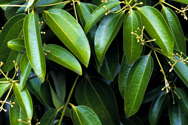
Photo © Steven Foster
Introduction
Camphor is a tall, many-branched evergreen tree with pointed, glossy leaves and clusters of small cream to yellow-green flowers followed by black berries.1 Camphor leaves release a strong fragrance when crushed.2 Native to Japan and tropical Southeast Asia,1 camphor now also grows in dry, disturbed areas in California and along the Gulf Coast of the U.S.,2 and is cultivated in India, Ceylon, Egypt, India, Madagascar, and southern Europe.3 Camphor essential oil is obtained by distillation from the wood.4 History and Cultural Significance
Camphor has been used by the Chinese for embalming, as an ingredient in soap,5 for wounds and skin diseases, and as a stimulant in unconsciousness.1 It has been applied externally as a folk remedy for gout, muscular strains, inflammations, itching skin, and as a weak antiseptic. In Mexico, camphor in olive oil is a popular topical remedy for bruises and pain.4 Topically, camphor is used to relieve pain, specifically on cold sores, hemorrhoids, warts, minor burns, and as an eardrop.6 Camphor is found in over-the-counter backache medications and products that treat skin conditions such as acne and oily skin. It is also a component in products used to treat bronchitis, chills, colds, coughs, and fever. Camphor has been used to increase blood flow to the skin, and has mild anesthetic and anti-itching properties.7 It is used as a moth repellent and as a preservative in pharmaceuticals and cosmetics.7 Camphor oil is used in skin care, for muscle and joint aches and pains; and as an insect repellent.3 Camphor is approved by the German Commission E for external use in the treatment of muscular rheumatism and inflammatory diseases of the respiratory tract.8 The U. S. Food and Drug Administration (FDA) has recognized camphor as safe and effective for topical use to relieve pain, cough, and itching.9 Modern Research
One clinical trial has been conducted in patients with various eye disorders using a multi-herb eye drop containing C. camphora.10 Studies have also been done testing camphor’s ability to repel and control various insects.11,12,13 Future Outlook
The sustainability of camphor is affected by harvesting procedures. In Japan, the root, trunk, and branches of the tree are all used, whereas in the US, only the leaves and twigs of the oldest trees are used, thereby causing less injury to the tree.5 Fortunately, many trees are found growing wild due to birds that spread the seeds from cultivated yards to open forests.2 References
1 Bown D. The Herb Society of America New Encyclopedia of Herbs. London: Dorling Kindersley Ltd; 2001. 2 Global Invasive Species. available at: http://www.issg.org/database/species/ecology.asp?si=291&fr=1&sts. Accessed February 1, 2005. 3 Lawless J. The Illustrated Encyclopedia of Essential Oils. Dorset, UK: Element Books; 1995. 4 Duke JA. CRC Handbook of Medicinal Herbs. Boca Raton, FL: CRC Press; 1985. 5 Grieve M. A Modern Herbal. New York: Dover Publications; 1971. 6 Jellin JM, Gregory PJ, Batz F, Hitchens K. eds. Natural Medicines Comprehensive Database, 5th edition. Stockton, CA: Therapeutic Research Faculty; 2002. 7 Hoffmann D. Medical Herbalism: the Science and Practice of Herbal Medicine. Rochester, VT: Healing Arts Press; 2003. 8 Blumenthal M, Busse WR, Goldberg A, Gruenwald J, Hall T, Riggins CW, Rister RS, editors. Klein S, Rister RS, translators. The Complete German Commission E Monographs¾Therapeutic Guide to Herbal Medicines. Austin, TX: American Botanical Council; Boston: Integrative Medicine Communication; 1998. 9 Anon. Camphor revisited: focus on toxicity. Committee on Drugs. Pediatrics. 4 July 1994. 94:1;127-128. 10 Biswas NR, Gupta SK, Das GK, Kumar N, Mongre PK, Haldar D, et al. Evaluation of Ophthacare® eye drops – a herbal formulation in the management of various ophthalmic disorders. Phytother Res. 2001 Nov;15(7):618-620. 11 Yang YC, Lee EH, Lee HS, Lee DK, Ahn YJ. Repellency of aromatic medicinal plant extracts and a steam distillate to Aedes aegypti. J Am Mosq Control Assoc. 2004 Jun;20(2):146-149. 12 Zhou Q, Liang G.[Effect of plant alcohol extracts on vegetable aphids and their parasitoids.]Ying Yong Shen Tai Xue Bao. 2003 Feb;14(2):249-252. 13 Rajapakse R, Van Emden HF. Potential of four vegetable oils and ten botanical powders for reducing infestation of cowpeas by Callosobruchus maculates, C. chinensis, and C. rhodesianus. J Stored Prod Res. 1997 Jan.33(1):59-68.
|